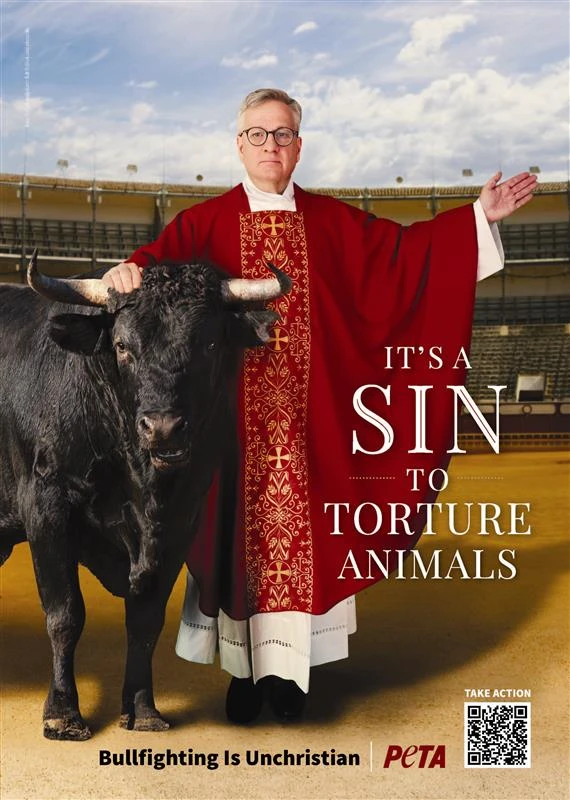
Father Terry Martin, a Catholic priest from West Sussex, England, has appeared in an advertisement for The Tablet denouncing bullfighting in his continued calls and efforts for Pope Francis to condemn the sport.
Partnering with People for the Ethical Treatment of Animals (PETA), Martin appears in a July 18 ad in red vestments posing alongside a bull with a caption reading: “It’s a sin to torture animals.”
Martin has long been outspoken in advocating for the welfare of animals, having sent a joint letter with priests from Canada and France to Pope Francis last year calling on him to condemn the “torture and violent slaughter of innocent bulls.”
This latest advertisement forms part of the PETA campaign that also beseeches the Holy Father to sever the Church’s links to the sport.
In an op-ed published in the Catholic Herald earlier this year, Martin cites the Holy Father’s 2015 encyclical letter Laudato Si’, which states that “every act of cruelty toward any creature is contrary to human dignity.”
“Paragraph 2418 of the Catechism of the Catholic Church also states: ‘[I]t is contrary to human dignity to cause animals to suffer or die needlessly,’” Martin continued. “Yet animals are taunted, terrorized, ridiculed, repeatedly stabbed, and eventually killed in bullfights.”
Bullfighting is a spectacle consisting of a physical contest between a bull and a matador in a sand arena in which the bull is normally killed.
Before facing the matador, the bull’s neck is pierced with banderillas, or barbed lance, by picadors (men on horseback). With the bull’s range of motion impaired by this act, the matador then attempts to kill the creature by either thrusting a sword into its lungs or cutting its spinal cord with a knife. Oftentimes, the bull may be paralyzed but still alive as its ears or tail are cut off and presented as trophies to the matador before ultimately having its body removed from the arena.
The first bullfight traces back to Spain in 711 A.D. when the coronation of King Alfonso III was being celebrated. While this spectacle is banned in Italy, England, and many countries across South America, the sport currently continues on in Spain, Portugal, France, Mexico, Peru, Venezuela, and Ecuador — all of which have Catholic majorities within their populations.
Speaking with CNA, Martin referenced his faith as being an encouragement in his endeavors to decry bullfighting, stating that it “allows me to see the entirety of God’s creation as a loving, divine gift. I believe, with the Church, that all animals are God’s creatures and that God has created them decisively and consciously as part of his plan for the life of the world. The balance of ecosystems, and the Genesis depiction of animals as ‘companions’ to human beings (2:19), is inspiring and beautiful.”
“Given that in Spain, and in some other countries, the Catholic Church is culturally caught up with bullfighting, the lack of logic and absence of Christian compassion strikes me forcibly,” he said. “It seems that many bullrings have chapels and chaplains, and that matadors (a word that can easily be translated from the Spanish as meaning ‘murderer’) queue up for the Church’s blessing. More than this, many horrendous bullfights and bull runs that exist are held in honor of Catholic saints and in celebration of their feast days.”
As mentioned in Martin’s earlier op-ed, various Catholic celebrations such as San Fermín and San Isidro in Spain, as well as the Feria de Pâques in France, have often featured bullfights and chapels built inside these bullrings.
Similarly, to celebrate the May 13 feast day of St. Peter de Regalado — a Franciscan friar who is considered a patron saint of bullfighters for having calmed the charge of bull that had escaped from a celebration near his convent — the town of Valladolid, Spain, hosts numerous bullfights as part of its annual San Pedro Regalado Fair.
In one of the Church’s stronger stances against bullfighting, Pope Pius V issued an edict in 1567 prohibiting bullfighting under the threat of excommunication. Although this ban was rescinded by his successor, Gregory XIII, only eight years later at the request of King Philip II, Pius suggested at the time that the sport was “removed from Christian piety and charity.”
Calling on Pope Francis to take similar actions, Martin cited No. 2416 of the catechism, stating that “this is the official teaching of the Church. I would have to ask, with charity and openness to my hearer, is bullfighting bearing testament to this — and does the Church’s apparent involvement (and even celebration) of bullfighting align with this teaching?”
While PETA’s positions and campaigns do not completely align with Church teaching, Martin credited the organization as having a “habit of dramatically drawing attention to the cruelty and suffering to which so many animals are subjected, both here and throughout the world.”
“PETA is not a Catholic or Christian organization per se, but it does have a section called ‘PETA Lambs’ for Christians who support their animal advocacy,” he continued. “For me, the call to show compassion and goodwill to all living beings is a fundamental part of my Catholic view of the world and of human nature. It seemed, therefore, right that I confirm my willingness to help them in these matters.”
Through participating in this campaign, Martin then expressed his hope that by “inviting people to think about the place of animals in creation, and to consider more deeply the relationship between animals and humans, there might be a moment of clarity and new insight.”
“I suggest that our Catholic faith perfectly aligns with a way that is more charitable, more understanding, more compassionate, more creation-centered, and more Christ-like than that,” he said.
